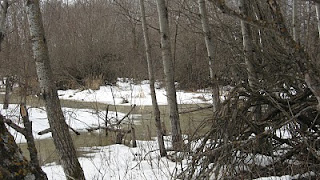 The trees are stirring in the afternoon breeze and the smell of spring is in the air. A chickadee flutters down and perches on the limb of a nearby chokecherry bush, singing it's happy tune as it watches me take another step forward through the slight crust of snow under my foot. Ahead, there lies a white, snow covered clearing, stretching out to the meadow beyond.
The trees are stirring in the afternoon breeze and the smell of spring is in the air. A chickadee flutters down and perches on the limb of a nearby chokecherry bush, singing it's happy tune as it watches me take another step forward through the slight crust of snow under my foot. Ahead, there lies a white, snow covered clearing, stretching out to the meadow beyond. My eyes scan the scraggly clump of willow in front of me . . . searching. A hidden treasure rests just ahead of where I stand. A treasure that most would never think of as they passed by. Another step brings me closer to the darkened, weathered, moss covered, stand of willow bushes. The ground beneath has just barely been uncovered revealing last year's fallen leaves.
Making my way through the tangle of fallen limbs and sticks, I glanced down and saw murky water swelling up in the tracks my feet had made. I was in a slight depression in the ground, barely two feet at it deepest from the surrounding forest floor, that had accumulated an amount of snow. My boots were nearly sunken in to their top, and my left foot began to feel wet as the water made it's way through a crack in the rubber.
The wind swayed the trees that hung out over the clearing and I began to redouble my efforts of finding the treasure, fearing that I may have begun in the wrong place. There! Just a few yards to my left, I spotted it. Suspended by its long shaft that merged into the main trunk, was a curiously shaped bulge in the wood surrounded by numerous other "diamonds."
---------------------------------------------------------------
In numerous places on our property we have diamond willow bushes growing. Most of the bushes were flooded when the beavers dammed up the lake overflow, so many of them are dead and dried out. There are still some that are living in the wet spots and a few afternoons ago I went out and cut a few particularly nice shaped ones. Before the bark is peeled away, the stick doesn't look that nice, but in some places the wood is full of twists and hollow spots that are referred to as "diamonds."
---------------------------------------------------------------
In numerous places on our property we have diamond willow bushes growing. Most of the bushes were flooded when the beavers dammed up the lake overflow, so many of them are dead and dried out. There are still some that are living in the wet spots and a few afternoons ago I went out and cut a few particularly nice shaped ones. Before the bark is peeled away, the stick doesn't look that nice, but in some places the wood is full of twists and hollow spots that are referred to as "diamonds."
A lot of people like to make canes or walking sticks out of diamond willow because of the unique red color of the wood and diamonds. When the sticks dry, the wood turns red, but if it is cut green and peeled, the wood is white and the diamonds are red making a really nice looking cane or walking stick.
This afternoon I boxed up some sticks with the bark on and will be shipping them out to Idaho soon for someone that ordered them.
Peter





1 comment:
Great story Peter.
Had to read it all once I started.
Writing must be a family gene.
Gp B
Post a Comment